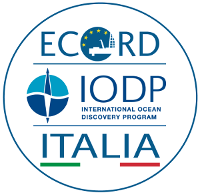Maggiori dettagli sono riportati di seguito, call e application form al link http://www.ecord.org/expeditions/apply-to-sail/,
La documentazione richiesta nel bando dovrà essere trasmessa via email all'ESSAC Office essac@plymouth.ac.uk e in copia a iodp-italia@cnr.it
La SCADENZA per presentare le domande di partecipazione è il 30 Settembre 2018.
Saluti cordiali,
Annalisa Iadanza
http://www.iodp-italia.cnr.it/index.php/it/opportunita/supporto-iodp-italia

SPECIAL CALL FOR APPLICATIONS
for scientists with expertise in Diatom Biostratigraphy/Micropaleontology and Nannofossil Biostratigraphy/Micropaleontology
based in ECORD Member Countries to participate in
based in ECORD Member Countries to participate in
IODP Expedition 385:
Guaymas Basin Tectonics and Biosphere
on-board the JOIDES Resolution
DEADLINE to apply: 30 September 2018
The European Consortium for Ocean Research Drilling (ECORD) offers you the unique opportunity to sail on Expedition 385 on-board the JOIDESR esolutionin the framework of the International Ocean Discovery Program (IODP), an international research program for drilling at sea.
IODP Expedition 385 (based on IODP Proposals 833-Full2 and 833-Add) will core and log a series of sites in the Guaymas Basin to investigate the relationships between tectonics, magmatism, sedimentation, carbon cycling, and microbial activity. The Guaymas Basin in the Gulf of California is a young, marginal rift basin characterized by active seafloor spreading and rapid deposition of organic-rich sediments from highly productive overlying waters. The active formation of oceanic crust combined with a thick sedimentary overburden has given rise to a dynamic environment, where strongly connected physical, chemical, and biological processes govern the cycling of sedimentary carbon. Its fate upon deposition depends on the relative efficiencies of interrelating microbial and chemical processes, leading either to sequestration or release of carbon. Expedition 385 aims to illuminate the interaction between these processes and its ultimate consequences for carbon cycling, which will help understand similar settings in marginal seas throughout the world.
Drilling toward and through seismically imaged sills of varying age and temperature into the intercalated sill-sediment package will provide core and log data to constrain the links between sediment accumulation, sill emplacement, sediment alteration, fluid expulsion, as well as microbial utilization and sequestration of carbon along sub-seafloor fluid pathways. The primary objectives are to:
IODP Expedition 385 (based on IODP Proposals 833-Full2 and 833-Add) will core and log a series of sites in the Guaymas Basin to investigate the relationships between tectonics, magmatism, sedimentation, carbon cycling, and microbial activity. The Guaymas Basin in the Gulf of California is a young, marginal rift basin characterized by active seafloor spreading and rapid deposition of organic-rich sediments from highly productive overlying waters. The active formation of oceanic crust combined with a thick sedimentary overburden has given rise to a dynamic environment, where strongly connected physical, chemical, and biological processes govern the cycling of sedimentary carbon. Its fate upon deposition depends on the relative efficiencies of interrelating microbial and chemical processes, leading either to sequestration or release of carbon. Expedition 385 aims to illuminate the interaction between these processes and its ultimate consequences for carbon cycling, which will help understand similar settings in marginal seas throughout the world.
Drilling toward and through seismically imaged sills of varying age and temperature into the intercalated sill-sediment package will provide core and log data to constrain the links between sediment accumulation, sill emplacement, sediment alteration, fluid expulsion, as well as microbial utilization and sequestration of carbon along sub-seafloor fluid pathways. The primary objectives are to:
- Explore the physical and chemical gradients along active and extinct fluid pathways associated with sill emplacement;
- Investigate subsurface microbial communities that are sustained by alteration products, in order to determine how efficiently they capture carbon-bearing alteration products; and
- Advance our understanding of the conditions that limit life in the deep biosphere.
Coring sill-sediment successions will provide an integrated record of igneous accretion as well as baseline data of carbon flux, including unaltered subsurface sediments and those that have experienced multiple generations of sill intrusion at depth. Petrophysical data (e.g., porosity/permeability) will also constrain crustal fluid flow and heat exchange that exert fundamental controls on this system. All findings will deepen our understanding of mechanisms of carbon remobilization implicated in global-scale rapid climate change.
For more information about the expedition science objectives and the JOIDES Resolution Expedition Schedule see http://iodp.tamu.edu/scienceops/ - this includes links to the individual expedition web pages with the original IODP proposal and expedition planning information.
For more information about the expedition science objectives and the JOIDES Resolution Expedition Schedule see http://iodp.tamu.edu/scienceops/ - this includes links to the individual expedition web pages with the original IODP proposal and expedition planning information.
WHO SHOULD APPLY: Scientists with expertise in Diatom Biostratigraphy/Micropaleontology and Nannofossil Biostratigraphy/Micropaleontology.
The Application Process is open to scientists in all ECORD member countries. Please download theApply to Sailgeneralapplication forms from the ESSAC webpage:
http://www.ecord.org/expeditions/apply-to-sail/
Please, fill out all applicable fields and send it to the ESSAC office by email (essac@plymouth.ac.uk) with the following additional documents by the deadline of 30 September 2018:
Please, fill out all applicable fields and send it to the ESSAC office by email (essac@plymouth.ac.uk) with the following additional documents by the deadline of 30 September 2018:
- A letter of interest outlining your specific expertise, previous involvement in DSDP/ ODP/ IODP expeditions, research interests, primary research goals of your proposed participation.
- CV and publication list.
- Young researchers must additionally provide a letter of support from their host institution, including information on post-cruise science support.
All applications should state how you intend to achieve your proposed scientific objectives, with information on the funding scheme and support from your institution or national funding agencies. More information can be found under: http://www.ecord.org/expeditions/apply-to-sail/
In addition to the ESSAC application, all applicantsmust inform their national office or national delegateand send them a copy of their application documents. The national offices or national delegates can also provide information regarding travel support, post-cruise funding opportunities, etc.
See http://www.ecord.org/about-ecord/about-us/ for a list of the national contact persons.
For further information or questions, please contact the ESSAC Office:
ECORD Science Support & Advisory Committee
Antony Morris (ESSAC Chair)
Hanno Kinkel (ESSAC Science Coordinator)
School of Geography, Earth and Environmental Sciences,
Plymouth University, UK
Drake Circus, Plymouth PL4 8AA, UK
e-mail: essac@plymouth.ac.uk
website: www.ecord.org

ECORD - European Consortium for Ocean Research Drilling
www.ecord.org







